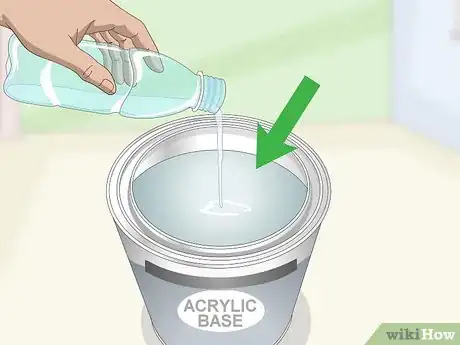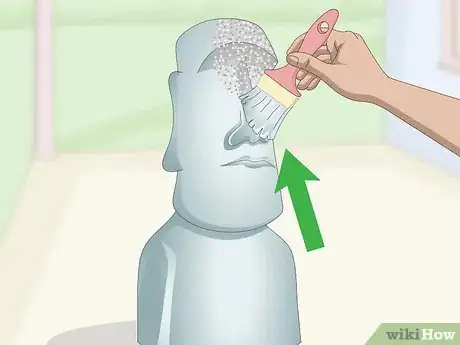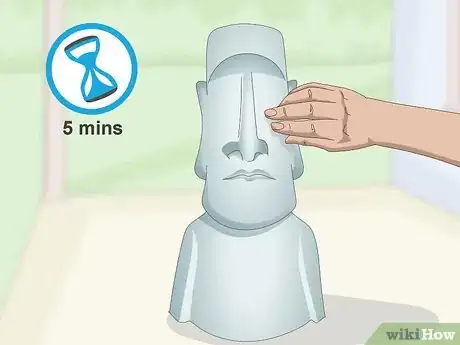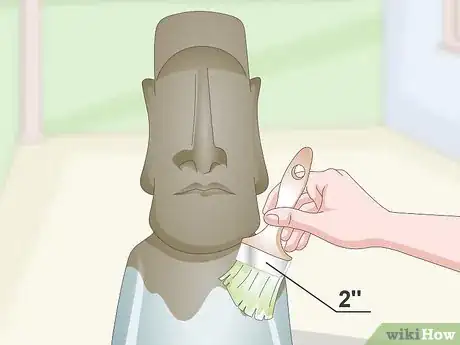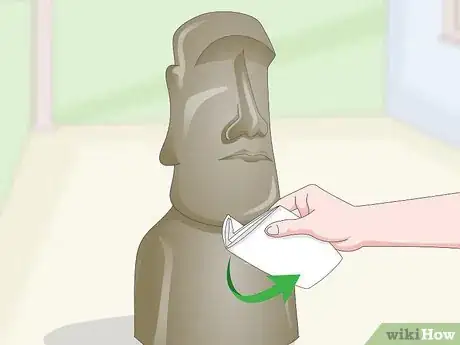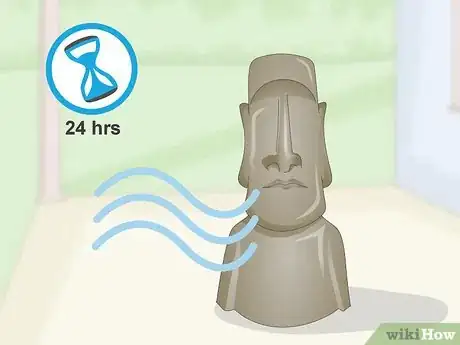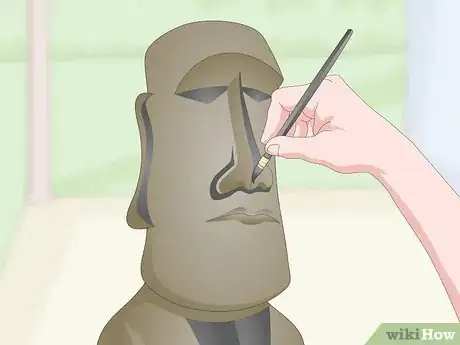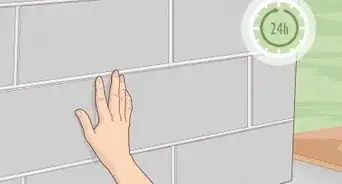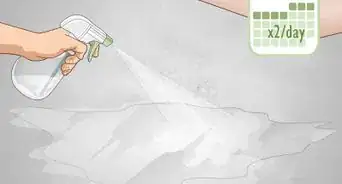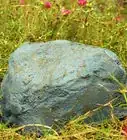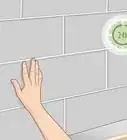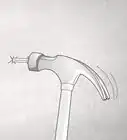This article was co-authored by Kelly Medford. Kelly Medford is an American painter based in Rome, Italy. She studied classical painting, drawing and printmaking both in the U.S. and in Italy. She works primarily en plein air on the streets of Rome, and also travels for private international collectors on commission. She founded Sketching Rome Tours in 2012 where she teaches sketchbook journaling to visitors of Rome. Kelly is a graduate of the Florence Academy of Art.
There are 16 references cited in this article, which can be found at the bottom of the page.
wikiHow marks an article as reader-approved once it receives enough positive feedback. This article received 25 testimonials and 96% of readers who voted found it helpful, earning it our reader-approved status.
This article has been viewed 559,541 times.
Concrete statues are commonly found as yard ornaments or objects of interior décor. Because concrete is porous, it is important to clean it, apply a base coat, paint it, and seal it to make the beauty last. When well-cared for, your concrete statuary can be eye-catching and unique.
Things You Should Know
- Scrub the statue with water (no soap!) and a brush, then let it air dry. Fill in any cracks with epoxy putty and wait 3-4 hours for it to dry.
- Wet the statue and apply an acrylic base coat. Add some water to the paint to help it adhere to the concrete, then paint from the bottom of the statue up.
- Add a top coat of acrylic latex paint and wait 24 hours for it to cure. Seal the statue with a UV and water sealant to protect it from the elements.
Steps
Cleaning the Concrete Statue
-
1Put the statue in a bucket of plain water and scrub it with a large brush. Don’t use soap in the water since it may have a negative effect on the concrete and the overall painting process. Scrub the statue until you get the large areas as clean as you’d like them. Use a toothbrush to scrub the smaller nooks and crannies in the statue.[1]
-
2Take the statue out of the bucket and let it dry in the sun. It should take a few minutes to dry, depending on how warm the air is. Air drying the statue will kill any moss that’s left behind. Concrete statues look more pristine when they’ve been dried in the sun and when they don’t have any moss on their surfaces.[2]
- Don’t leave concrete statuary to dry outside in the winter, because moisture will collect in its pores, causing it to expand and eventually crack.
Advertisement -
3Fill in cracks with epoxy putty. Choose a putty that is the same color as the statue, or close enough. So, if the statue is white or gray use silver or gray putty. Break off a couple pieces of epoxy putty or however many you need to fill in each crack. Smooth it over using a wet spatula or a knife and let the putty dry for 3 to 4 hours. [3]
- You can find epoxy putty in craft stores.
- Wear gloves when handling epoxy putty to protect your skin from irritation.
- Use a blow dryer to set the putty quickly.
- You can use epoxy putty to replace missing pieces from a concrete statue, such as toes. The putty becomes hard as a rock once it’s dried, so no one will know a toe was ever missing.
Applying the Base Coat
-
1Dump water on the statue to make the paint stain the concrete. Before applying a base coat getting the statue wet will ensure that that paint stains it under the surface, rather than just coating the surface. Concrete is porous, so the water will pull the paint further in to make the base coat more permanent.[4]
- Have a container of clean water ready for drenching the statue. There is no set recommended amount of water to use on the statue, as long as it’s soaked through.
-
2Mix water with your acrylic base coat to ensure it’s absorbed well. It doesn’t hurt to add water to the actual paint, because this will help it to soak into the concrete. When you water down a basecoat, the concrete absorbs it and stains better.[5]
- There is no recommended ratio of water to use.
- If you plan to use an antiquing or detailing method on the statue, choose white paint for the base coat.
-
3Coat the bottom of the concrete statue with the base coat first. You should paint the bottom first, because you would leave finger smudges in the paint on the top of the statue if you painted the bottom last. Place it on its side to let the bottom dry.
- This should be the same paint that you’re using as the base coat for the rest of the statue.
-
4Apply a base coat to the entire statue using a 2 in (5.1 cm) chip brush. Use an acrylic latex exterior paint for the base coat. The paint can be any color, but popular base coats are black, gray, and brown.[6]
-
5Inspect the statue after letting the basecoat dry for 5 minutes. Feel it with your hand for wet paint. If it’s completely dry, then it’s ready for the top coat. On a warm day the paint may dry in 5 minutes. It may take a little more time on a humid day.[7]
- Keep the wet statue away from pets and children who may tamper with it.
Painting and Sealing the Statue
-
1Use acrylic latex paint on concrete statues. For concrete statuary, water-based acrylic latex paints are recommended for their ability to soak into the concrete and stain it beyond its surface. Acrylic latex paints also don’t dry and crack like a shell over time, like oil-based paint does.[8]
-
2Paint the top coat using the dry-brush method. Dip a 2 in (5.1 cm) chip paintbrush into the color you chose as the top coat. Wipe most of the paint off on a piece of cardboard so that there’s almost no paint left on the bristles. With the brush almost dry, paint against the details of the statue using a back-and-forth dusting motion.[11]
- Make furry animal statues stand out by painting them with a base coat, and then dry-brushing a solid color over it. For example, dry-brush brown paint over a black base. Soften the brown with some white paint dusted over it.[12]
-
3Give the statue a weathered effect by antiquing it, if desired. After applying the top coat, wipe away the excess paint using a paper towel. Apply and wipe away paint as necessary to get the desired effect. A small amount of the base coat should be exposed throughout the statue to make the color look faded.[13]
- Concrete leaf stepping stones are an example of statues that look good with an antiquing method.
-
4Leave the top coat to dry for 24 hours. Allow the top coat to dry for 24 hours before moving on to the next step in painting concrete. Let it sit outside if it’s warm and dry out.[14]
-
5Highlight a statue’s features with the detailing technique. Detailing involves using small brushes to create details in the top coat by hand and using multiple colors of paint. Use this technique to fill in features such as eyes, noses, and clothes on statues. Detailing can be used when you’re painting animal statues with feathers and beaks or gnomes with clothes, for instance.
- One example is if you’re painting a manatee statue and want to give it some pink coloring on its cheeks; use a small brush and give its cheeks a dusting of pink paint.[15]
-
6Cover the statue with a UV/water sealant to protect the paint from the elements. Place the concrete statue on a ventilated surface, such as gravel or rock, when you apply the sealant. Leave it there for 24 hours to dry. Sealants make paint last longer and prevent it from flaking off. Sealants come as sprays and in the form of a paint. They protect paint colors from fading and repel harmful moisture.[16]
- You can also buy a can of clear enamel spray to make the statue look glossy.[17]
Expert Q&A
Did you know you can get premium answers for this article?
Unlock premium answers by supporting wikiHow
-
QuestionCan you spray paint concrete statues?
 Kelly MedfordKelly Medford is an American painter based in Rome, Italy. She studied classical painting, drawing and printmaking both in the U.S. and in Italy. She works primarily en plein air on the streets of Rome, and also travels for private international collectors on commission. She founded Sketching Rome Tours in 2012 where she teaches sketchbook journaling to visitors of Rome. Kelly is a graduate of the Florence Academy of Art.
Kelly MedfordKelly Medford is an American painter based in Rome, Italy. She studied classical painting, drawing and printmaking both in the U.S. and in Italy. She works primarily en plein air on the streets of Rome, and also travels for private international collectors on commission. She founded Sketching Rome Tours in 2012 where she teaches sketchbook journaling to visitors of Rome. Kelly is a graduate of the Florence Academy of Art.
Professional Painter
-
QuestionIs painting concrete a good idea?
 wikiHow Staff EditorThis answer was written by one of our trained team of researchers who validated it for accuracy and comprehensiveness.
wikiHow Staff EditorThis answer was written by one of our trained team of researchers who validated it for accuracy and comprehensiveness.
Staff Answer wikiHow Staff EditorStaff Answer
wikiHow Staff EditorStaff Answer -
QuestionHow long does painted concrete last?
 wikiHow Staff EditorThis answer was written by one of our trained team of researchers who validated it for accuracy and comprehensiveness.
wikiHow Staff EditorThis answer was written by one of our trained team of researchers who validated it for accuracy and comprehensiveness.
Staff Answer wikiHow Staff EditorStaff Answer
wikiHow Staff EditorStaff Answer
Warnings
- Spray paint is not recommended for painting concrete statuary, because it doesn’t last, and it looks bad.⧼thumbs_response⧽
References
- ↑ https://youtu.be/Ju7snz-kkwA?t=41
- ↑ https://youtu.be/Ju7snz-kkwA?t=97
- ↑ https://www.realhomes.com/advice/how-to-restore-a-garden-statue
- ↑ https://youtu.be/hq0C6toEyEo?t=187
- ↑ https://youtu.be/hq0C6toEyEo?t=197
- ↑ https://youtu.be/hq0C6toEyEo?t=159
- ↑ https://youtu.be/hq0C6toEyEo?t=291
- ↑ https://youtu.be/hq0C6toEyEo?t=160
- ↑ https://youtu.be/lZE1iKzxFBc?t=69
- ↑ https://youtu.be/hq0C6toEyEo?t=568
- ↑ https://youtu.be/hq0C6toEyEo?t=398
- ↑ https://youtu.be/lZE1iKzxFBc?t=82
- ↑ https://www.madebybarb.com/2017/04/29/how-to-antique-concrete-to-look-aged/
- ↑ https://youtu.be/hq0C6toEyEo?t=398
- ↑ https://youtu.be/fbnYy291cOw?t=325
- ↑ https://youtu.be/DQtqea7-ZT8?t=99
- ↑ https://youtu.be/hq0C6toEyEo?t=637
About This Article
To paint a concrete statue, start by dumping water over it so it's soaked, which will help the paint absorb better. Then, mix some acrylic paint with a little bit of water and apply a base coat to the statue using a 2-inch chip brush. Once the base coat is dry, which should take around 5 minutes, add your top coat using more acrylic paint and the same brush. Finally, let the top coat dry for 24 hours before applying a UV and water sealant to the statue. To learn how to clean concrete before you paint it, read on!




